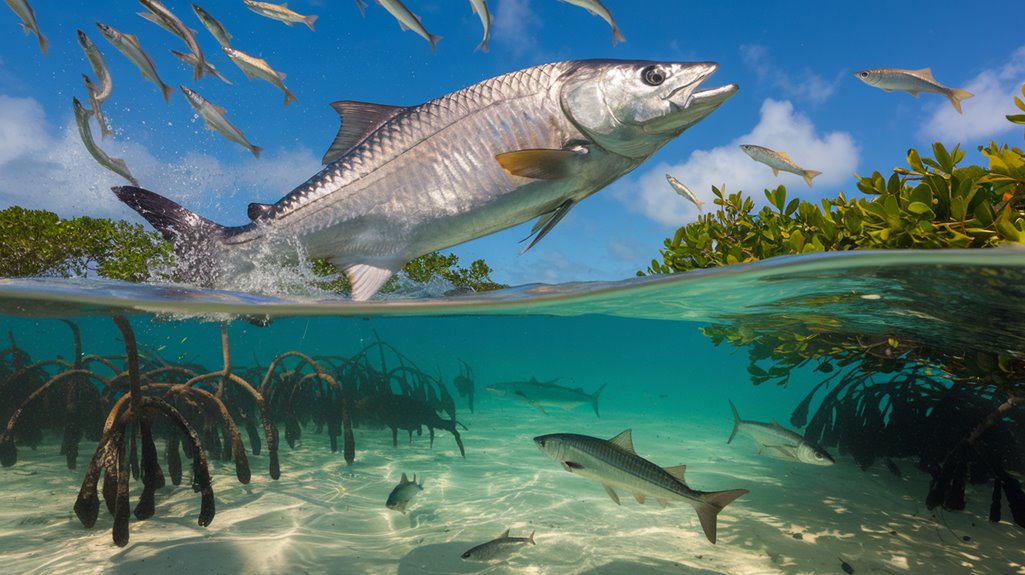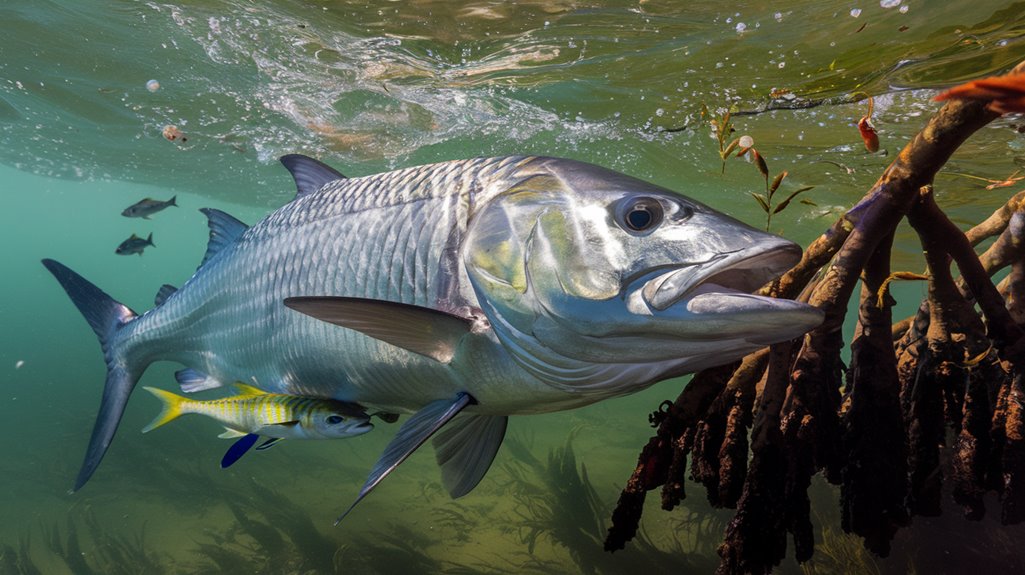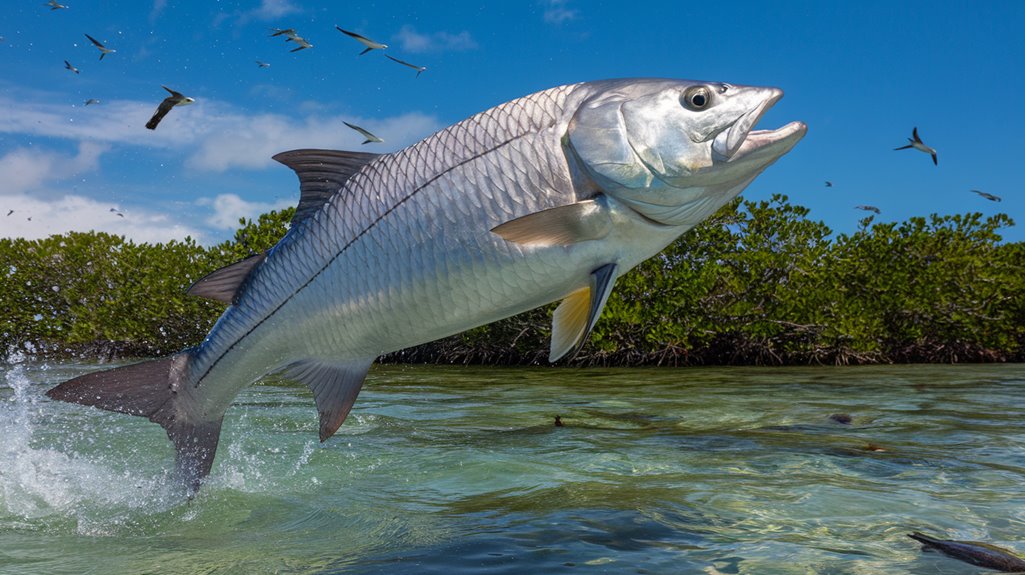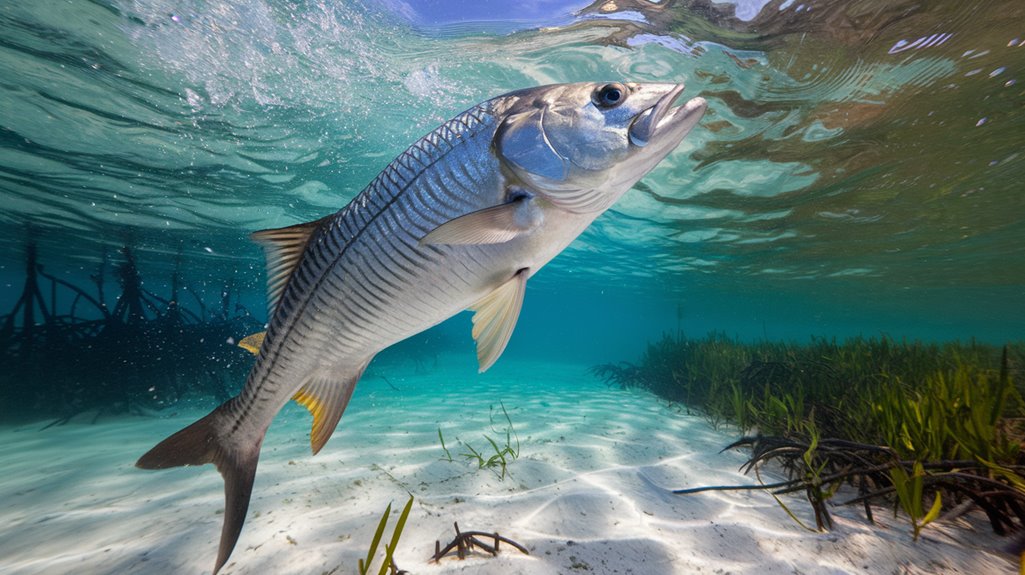You'll discover that tarpon (Megalops atlanticus) function as essential ecosystem engineers in coastal marine environments. Through their predatory activities and migratory patterns, they've established intricate trophic relationships that maintain population equilibrium among smaller fish species. Their presence directly influences nutrient cycling and energy flow within estuarine systems, while serving as biological indicators of habitat quality. Understanding these complex ecological dynamics will reveal why tarpon deserve heightened conservation attention.
- Key Takeaways
- The Historical Significance of Tarpon in Marine Ecosystems
- Predator-Prey Relationships and Food Web Dynamics
- Habitat Requirements and Population Distribution
- Environmental Indicators and Ecosystem Health
- Economic Impact on Coastal Communities
- Threats to Tarpon Population Survival
- Conservation Efforts and Management Strategies
- Research Methods and Scientific Findings
- Future Outlook for Tarpon Conservation
- Frequently Asked Questions
- Conclusion
Key Takeaways
- Tarpon are keystone species that significantly influence coastal biodiversity through their predatory role in marine ecosystems.
- As apex predators, tarpon regulate prey populations through opportunistic feeding, maintaining ecosystem balance and health.
- Juvenile tarpon support critical nursery habitats by controlling small fish and invertebrate populations in estuaries.
- Population declines can trigger trophic cascades, destabilizing marine communities and affecting overall ecosystem functionality.
- Tarpon presence serves as a biological indicator of ecosystem health, reflecting prey diversity and habitat quality.
The Historical Significance of Tarpon in Marine Ecosystems

As marine ecosystems have evolved over millennia, Atlantic tarpon (*Megalops atlanticus*) have emerged as keystone species that shape coastal biodiversity through their dual roles as both predator and prey. You'll find that their ecological characterization in Texas waters during the 1920s-1940s exemplifies their crucial function in maintaining healthy estuarine environments.
These magnificent fish have historically influenced marine community structures by regulating prey populations and supporting critical nursery habitats. Their presence in coastal waters has been instrumental in facilitating the recruitment of juvenile fish species, contributing to ecosystem resilience. Today's conservation efforts recognize that tarpon's historical significance extends beyond their individual populations – they're integral to the broader marine ecosystem's stability, making their protection essential for preserving coastal biodiversity and ecological balance.
Predator-Prey Relationships and Food Web Dynamics
The predator-prey dynamics of Atlantic tarpon (*Megalops atlanticus*) reveal intricate relationships that shape marine food web structures. You'll find these apex predators exercising significant control over prey populations through their opportunistic feeding behaviors, which encompass both active hunting and scavenging strategies.
The ecological characterization of juvenile tarpon is particularly significant in estuarine nursery habitats, where they're essential regulators of small fish and invertebrate populations. This predatory pressure helps maintain ecosystem health by preventing any single prey species from becoming overly abundant. When tarpon populations decline, you'll observe disruptions in these carefully balanced predator-prey dynamics, potentially triggering trophic cascades that can destabilize entire marine communities. Their presence serves as a critical indicator of ecosystem functionality, reflecting the availability and diversity of prey species within their habitat.
Habitat Requirements and Population Distribution

You'll find Atlantic tarpon thriving in specific nursery habitats like estuaries and coastal lagoons, where juvenile survival rates directly influence adult population abundance. These nursery zones require precise water quality parameters and exhibit seasonal occupancy patterns based on environmental conditions and prey availability, particularly along coastlines where anthropogenic development hasn't degraded habitat quality. The species' distribution follows distinct migration corridors that connect these critical nursery areas to adult feeding grounds, forming a network of essential habitats that support different life stages of the population.
Critical Nursery Areas
Maintaining robust tarpon populations depends critically on the availability and quality of nursery habitats, where juvenile Megalops atlanticus undergo essential developmental stages. You'll find these nursery habitats primarily in estuaries and shallow coastal areas, which provide crucial resources for early life stages. Research shows that degradation of these critical zones has led to recruitment failure, directly impacting juvenile survival rates and adult population numbers.
You'll notice significant seasonal and interannual variations in juvenile tarpon presence within these areas, emphasizing the need for targeted conservation strategies during peak recruitment periods. Through citizen science initiatives, researchers have identified and validated key nursery habitats, enhancing our understanding of juvenile tarpon distribution patterns. Effective habitat protection measures are fundamental to conservation strategies, as these nursery areas serve as the cornerstone for sustaining tarpon populations.
Migration Patterns By Season
Driven by seasonal environmental cues, Atlantic tarpon undertake complex migratory movements that greatly influence their habitat utilization and population distribution. You'll observe these migration patterns shift from offshore to inshore waters during late spring, as juveniles seek vital nursery habitats in estuaries and mangroves.
| Season | Location | Primary Activity |
|---|---|---|
| Spring | Inshore Waters | Feeding/Growth |
| Summer | Estuaries | Nursery Development |
| Fall/Winter | Offshore Waters | Migration/Spawning |
Research demonstrates that habitat loss and reduced freshwater inflow have profoundly impacted juvenile tarpon populations. Movement-based studies indicate that these fish strategically select habitats based on prey availability and water quality parameters. You'll find higher concentrations of tarpon in areas where these conditions align with their biological requirements, making habitat conservation essential for species survival.
Water Quality Preferences
Water quality parameters serve as fundamental determinants of tarpon habitat selection and population distribution, building upon their seasonal migration patterns. You'll find juvenile tarpon thriving in brackish waters with specific salinity ranges of 10-30 ppt, particularly in coastal estuaries and mangrove-dominated nursery habitats. These young fish demonstrate precise habitat use preferences, requiring water temperatures between 25°C and 30°C for ideal growth and survival. High dissolved oxygen levels are essential to support their unique air-breathing adaptations and active lifestyle. The success of tarpon populations directly correlates with water quality conditions, as they're sensitive to nutrient loading and pollutants. Their distribution patterns reflect this sensitivity, with populations declining in areas where coastal development and altered freshwater flows compromise their essential nursery habitats.
Environmental Indicators and Ecosystem Health

As robust bioindicators of marine ecosystem health, Atlantic tarpon (*Megalops atlanticus*) provide scientists with essential data about environmental conditions in coastal waters. You'll find these important species particularly sensitive to shifts in habitat conditions, making them excellent markers for ecological characterization. Their presence or absence helps you assess the environmental characteristics of coastal ecosystems, especially in estuarine nursery areas.
When you monitor tarpon populations, you're actually gathering vital data about entire marine food webs. Their role in predator-prey dynamics makes them key indicators of ecosystem stability. You'll notice that healthy tarpon populations often correlate with nutrient-rich waters and diverse prey availability. Their effectiveness as bioindicators underscores the critical importance of preserving their habitats for maintaining overall marine ecosystem resilience.
Economic Impact on Coastal Communities
You'll find that tarpon fishing generates substantial tourism revenue exceeding $689 million annually in Texas alone, driving economic importance through lodging, dining, and recreational expenditures in coastal regions. The recreational fishing market creates a robust employment ecosystem, supporting guide services, tackle retailers, and charter operations that provide sustainable livelihoods for coastal residents. These economic benefits extend beyond direct revenue generation, as the preservation of tarpon habitats catalyzes broader marine ecosystem health, which sustains commercial fishing industries and strengthens coastal communities' long-term economic resilience.
Tourism Revenue Generation
The economic impact of tarpon fishing reverberates throughout coastal communities, generating substantial revenue streams that extend far beyond direct fishing activities. You'll find this important species driving tourism across coastal regions, where the ecological and recreational value creates multi-layered economic benefits.
- Florida's tarpon fishery generates over $1 billion annually through recreational activities
- Charter services and equipment retailers benefit from sustained angler demand
- Tournament events attract thousands, injecting significant capital into local economies
- Texas's tarpon-focused tourism draws nationwide visitors, boosting hospitality sectors
- Healthy tarpon populations sustain long-term tourism viability
The symbiotic relationship between tarpon presence and tourism revenue demonstrates how conservation of this species directly influences regional economic prosperity. Destinations featuring robust tarpon populations consistently attract higher visitor spending across accommodations, dining, and retail sectors.
Employment Opportunities Created
Beyond tourism revenue, tarpon fishing creates a diverse employment ecosystem throughout coastal regions. You'll find that recreational fisheries centered around tarpon generate substantial job opportunities across multiple sectors. The $689 million annual economic impact translates into employment for fishing guides, tackle shop operators, and hospitality workers. Conservation measures implemented to protect tarpon populations have created additional positions in habitat restoration and marine resource management.
Coastal communities benefit from specialized employment opportunities through tarpon fishing tournaments, which require event coordinators, safety personnel, and support staff. The sustainable catch-and-release practices you're required to follow have fostered jobs in environmental education and compliance monitoring. This interconnected network of employment spans both direct fishing-related positions and auxiliary services that support the recreational fishing industry.
Recreational Fishing Markets
Within coastal communities, recreational tarpon fishing markets generate substantial economic ripples that extend far beyond direct angling activities. You'll find that these fisheries contribute over $689 million annually to coastal economies, creating a robust economic framework that supports multiple business sectors and conservation measures.
- Charter operations and guide services form the primary revenue stream, offering specialized tarpon fishing experiences
- Bait shops, tackle stores, and equipment retailers benefit from consistent angler demand
- Tourism-related businesses, including hotels and restaurants, experience increased patronage
- Local employment opportunities expand through direct and indirect fishing-related services
- Conservation initiatives receive funding support, helping maintain healthy tarpon populations
This economic ecosystem demonstrates the intricate relationship between recreational fishing, community prosperity, and species conservation, highlighting the importance of sustainable management practices in preserving both ecological and economic benefits.
Threats to Tarpon Population Survival
Despite their remarkable resilience as a species, Atlantic tarpon (Megalops atlanticus) face mounting existential pressures that threaten their long-term survival. You'll find that overfishing, particularly in areas with high recreational and commercial activity, has greatly impacted their population dynamics. The degradation of critical habitats, exacerbated by coastal development and altered freshwater flow patterns, has severely compromised juvenile tarpon recruitment. Post-1960 fishing data reveals an alarming decline in juvenile capture rates, indicating recruitment failure linked to nursery habitat deterioration. The species' limited commercial value has resulted in insufficient conservation measures, despite their ecological significance. Population modeling demonstrates that reduced juvenile survival rates directly correlate with declining adult abundance, creating a devastating feedback loop that threatens the species' persistence in affected regions.
Conservation Efforts and Management Strategies
While tarpon populations continue to decline, extensive conservation initiatives have emerged to protect this ecologically significant species. Resource managers have implemented multi-faceted conservation measures focusing on juvenile survival and nursery habitats preservation. You'll find thorough strategies that integrate scientific research with practical management approaches.
- Establishment of marine protected areas to safeguard critical habitats and restrict recreational harvesting
- Implementation of catch-and-release protocols to minimize population impacts
- Engagement of citizen scientists in tagging programs for movement tracking
- Protection of essential nursery habitats to enhance juvenile survival rates
- Development of water quality management initiatives to preserve ecosystem health
These evidence-based conservation efforts demonstrate the scientific community's commitment to tarpon preservation through integrated management approaches. You'll see how these strategies address both immediate threats and long-term sustainability goals, utilizing data-driven decision-making processes to optimize population recovery efforts.
Research Methods and Scientific Findings
Scientists employ rigorous methodologies to study tarpon populations and their ecological dynamics through standardized bimonthly sampling protocols. Their research focuses on juvenile tarpon ecology, utilizing mark-recapture tagging and acoustic telemetry to track movement patterns and habitat usage. You'll find that researchers analyze water quality parameters and habitat characteristics while conducting thorough assessments of nursery habitats.
The scientific approach integrates monthly laboratory analyses of prey items, revealing critical information about feeding behaviors and nutritional requirements. Through acoustic telemetry and conventional tagging methods, you can observe how juvenile tarpon navigate their environment. Citizen scientists contribute valuable data, validating the identification of essential nursery habitats. This collaborative research methodology provides resource managers with evidence-based insights for implementing effective conservation strategies and understanding tarpon's role in marine ecosystems.
Future Outlook for Tarpon Conservation
Based on extensive ecological research and monitoring data, the future conservation of tarpon populations hinges on understanding juvenile habitat requirements and implementing targeted protection measures. Ecological characterization of nursery habitats along coastal zones will provide new information vital for species preservation.
- Citizen science initiatives enhance data collection and validation of critical nursery areas
- Post-1960 decline in juvenile populations necessitates immediate conservation measures
- Research-driven habitat restoration programs target specific environmental parameters
- Scientific partnerships with anglers strengthen monitoring capabilities
- Resource management strategies focus on protecting essential juvenile habitats
You'll find that collaborative efforts between scientists and stakeholders are revolutionizing tarpon conservation approaches. These partnerships facilitate thorough habitat assessment and protection strategies, ensuring the species' long-term survival through evidence-based conservation protocols and enhanced ecological understanding.
Frequently Asked Questions
What Is the Role of the Tarpon in the Ecosystem?
You'll find that tarpon function as apex predators, regulating prey populations and nutrient cycling in coastal ecosystems while serving as bioindicators of marine habitat health through their predatory-prey dynamics.
What Unique Adaptation Do the Tarpon Fish Have?
You'll find that tarpon possess a modified swim bladder functioning as a respiratory lung, enabling them to extract atmospheric oxygen while inhabiting hypoxic environments in both marine and estuarine ecosystems.
What Is the Lifespan of a Tarpon?
You'll find that Atlantic tarpon (Megalops atlanticus) exhibit remarkable longevity, typically surviving 50+ years in their natural habitat, with documented cases reaching 80 years, while achieving sexual maturity around age 4-6.
Are Tarpons Apex Predators?
You'll find that tarpon are indeed apex predators, occupying the top trophic level in their ecosystem, where they exercise significant predatory control over fish, crustaceans, and invertebrate populations.
Conclusion
You'll recognize tarpon's critical function as ecosystem engineers through their top-down trophic regulation and metapopulation dynamics. Their biomagnification potential and phenotypic plasticity demonstrate remarkable adaptive capacity. You must acknowledge how anthropogenic stressors threaten their metapopulation stability. Your support of science-based management protocols and habitat conservation initiatives remains essential for maintaining ecosystem homeostasis and preserving these keystone predators' functional role in coastal biomes.

